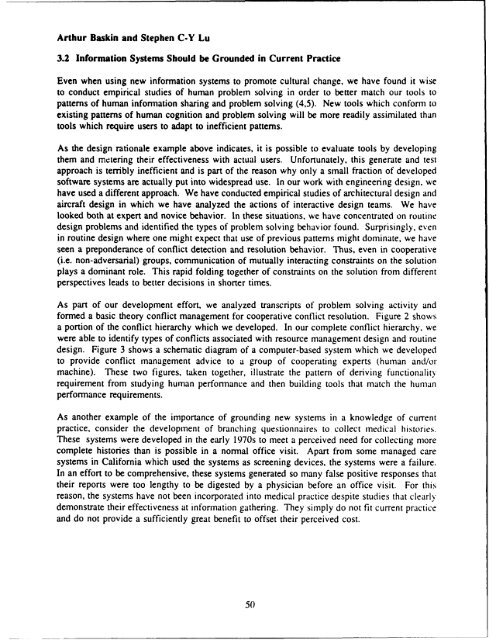Challenges and Opportunities for Innovation in the Public Works ...
Challenges and Opportunities for Innovation in the Public Works ...
Challenges and Opportunities for Innovation in the Public Works ...
You also want an ePaper? Increase the reach of your titles
YUMPU automatically turns print PDFs into web optimized ePapers that Google loves.
Arthur Bask<strong>in</strong> <strong>and</strong> Stephen C-Y Lu<br />
3.2 In<strong>for</strong>mation Systems Should be Grounded <strong>in</strong> Current Practice<br />
Even when us<strong>in</strong>g new <strong>in</strong><strong>for</strong>mation systems to promote cultural change, we have found it wise<br />
to conduct empirical studies of human problem solv<strong>in</strong>g <strong>in</strong> order to better match our tools to<br />
patterns of human <strong>in</strong><strong>for</strong>mation shar<strong>in</strong>g <strong>and</strong> problem solv<strong>in</strong>g (4,5). New tools which con<strong>for</strong>m to<br />
exist<strong>in</strong>g patterns of human cognition <strong>and</strong> problem solv<strong>in</strong>g will be more readily assimilated than<br />
tools which require users to adapt to <strong>in</strong>efficient patterns.<br />
As <strong>the</strong> design rationale example above <strong>in</strong>dicates, it is possible to evaluate tools by develop<strong>in</strong>g<br />
<strong>the</strong>m <strong>and</strong> meter<strong>in</strong>g <strong>the</strong>ir effectiveness with actual users. Un<strong>for</strong>tunately, this generate <strong>and</strong> test<br />
approach is terribly <strong>in</strong>efficient <strong>and</strong> is part of <strong>the</strong> reason why only a small fraction of developed<br />
software systems are actually put <strong>in</strong>to widespread use. In our work with eng<strong>in</strong>eer<strong>in</strong>g design, we<br />
have used a different approach. We have conducted empirical studies of architectural design <strong>and</strong><br />
aircraft design <strong>in</strong> which we have analyzed <strong>the</strong> actions of <strong>in</strong>teractive design teams. We have<br />
looked both at expert <strong>and</strong> novice behavior. In <strong>the</strong>se situations, we have concentrated on rout<strong>in</strong>e<br />
design problems <strong>and</strong> identified <strong>the</strong> types of problem solv<strong>in</strong>g behavior found. Surpris<strong>in</strong>gly, even<br />
<strong>in</strong> rout<strong>in</strong>e design where one might expect that use of previous patterns might dom<strong>in</strong>ate, we have<br />
seen a preponderance of conflict detection <strong>and</strong> resolution behavior. Thus, even <strong>in</strong> cooperative<br />
(i.e. non-adversarial) groups, communication of mutually <strong>in</strong>teract<strong>in</strong>g constra<strong>in</strong>ts on <strong>the</strong> solution<br />
plays a dom<strong>in</strong>ant role. This rapid fold<strong>in</strong>g toge<strong>the</strong>r of constra<strong>in</strong>ts on <strong>the</strong> solution from different<br />
perspectives leads to better decisions <strong>in</strong> shorter times.<br />
As part of our development ef<strong>for</strong>t, we analyzed transcripts of problem solv<strong>in</strong>g activity <strong>and</strong><br />
<strong>for</strong>med a basic <strong>the</strong>ory conflict management <strong>for</strong> cooperative conflict resolution. Figure 2 shows<br />
a portion of <strong>the</strong> conflict hierarchy which we developed. In our complete conflict hierarchy, we<br />
were able to identify types of conflicts associated with resource management design <strong>and</strong> rout<strong>in</strong>e<br />
design. Figure 3 shows a schematic diagram of a computer-based system which we developed<br />
to provide conflict management advice to a group of cooperat<strong>in</strong>g experts (human <strong>and</strong>/or<br />
mach<strong>in</strong>e). These two figures, taken toge<strong>the</strong>r, illustrate <strong>the</strong> pattern of deriv<strong>in</strong>g functionality<br />
requirement from study<strong>in</strong>g human per<strong>for</strong>mance <strong>and</strong> <strong>the</strong>n build<strong>in</strong>g tools that match <strong>the</strong> human<br />
per<strong>for</strong>mance requirements.<br />
As ano<strong>the</strong>r example of <strong>the</strong> importance of ground<strong>in</strong>g new systems <strong>in</strong> a knowledge of current<br />
practice, consider <strong>the</strong> development of branch<strong>in</strong>g questionnaires to collect medical histories.<br />
These systems were developed <strong>in</strong> <strong>the</strong> early 1970s to meet a perceived need <strong>for</strong> collect<strong>in</strong>g more<br />
complete histories than is possible <strong>in</strong> a normal office visit. Apart from some managed care<br />
systems <strong>in</strong> Cali<strong>for</strong>nia which used <strong>the</strong> systems as screen<strong>in</strong>g devices, <strong>the</strong> systems were a failure.<br />
In an ef<strong>for</strong>t to be comprehensive, <strong>the</strong>se systems generated so many false positive responses that<br />
<strong>the</strong>ir reports were too lengthy to be digested by a physician be<strong>for</strong>e an office visit. For this<br />
reason, <strong>the</strong> systems have not been <strong>in</strong>corporated <strong>in</strong>to medical practice despite studies that clearly<br />
demonstrate <strong>the</strong>ir effectiveness at <strong>in</strong><strong>for</strong>mation ga<strong>the</strong>r<strong>in</strong>g. They simply do not fit current practice<br />
<strong>and</strong> do not provide a sufficiently great benefit to offset <strong>the</strong>ir perceived cost.<br />
50







